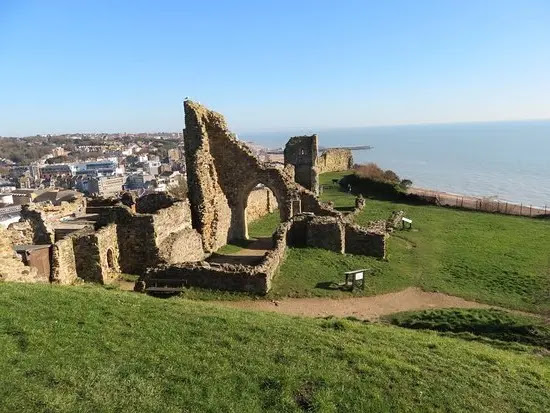
Discover East Sussex - East Sussex County Council "Coat of Arms". Find out what you can do and see in East Sussex with airGads.com and then book flights, car rental, and hotels in England using our site's easy system.
The present arms were granted by the College of Arms in 1975 and portray a Saxon crown, a wavy bar representing the County's maritime connections, and six Martlets. These are heraldic birds without legs or feet, and are said to represent swallows or house martins. They appear in the arms of several Sussex families but are not exclusive to the County. This coat was based on the design approved in 1937 with the addition of the wavy bar.
East Sussex, part of the old county of Sussex - from the Old English "Suo Saxe" or South Saxons, is a south coastal county running from Brighton eastwards, reaching as far as the ancient port of Rye. It covers almost 700 square miles and has a population of about 700,000. The administrative centre for East Sussex is Lewes. The County boasts a rich history of both Saxon and Norman times.
Apart from its history, East Sussex is also known for its natural beauty and dramatic coastline. The chalk hills of the South Downs run across the whole county, reaching the sea in an impressive line of cliffs, including the most famous one - "Beachy Head". The central & northern East Sussex is famous for the unspoilt villages offering insights into English country life, some of the better known are Heathfield, Mayfield and Uckfield.
10 Best Places to Visit in East Sussex (England):
1. Battle Abbey & Battlefield
grounds and ruins of the Benedictine abbey, founded by William the Conqueror on the battlefield, with an exhibition about the Battle of Hastings. William the Conqueror landed at Pevensey, beat King Harold at the battle of Hastings and the town of Battle and its abbey commemorate his victory.
2. Beachy Head
represents the highest chalk cliff in England, with magnificent views up to nearly 40 miles over the Channel! If you get bored of stunning views from the top of the cliff and the great countryside walks, you can always take a trip to nearby Eastbourne and embark on a bit of a shopping spree.
3. The Long Man of Wilmington
As many other chalk carved figures in England, The Long Man of Wilmington, mysterious guardian of the South Downs, has baffled archaeologists and historians for hundreds of years.

4. Herstmonceux
Built originally as a country home in the mid 15th Century, Herstmonceux Castle represents the history of Medieval England and the romance of Renaissance Europe. It is surrounded by beautiful parkland and stunning Elisabethan Gardens. Area round Herstmonceux was a significant place long before the Castle was built. There is evidence of Roman remains, and in the 12th century a Saxon Lady, Idonea de Herst married a Norman nobleman, Ingelram de Monceux, to give the place it's name.
5. Hastings
a charming town boasting rich history from the Roman and Saxon Times. Apart from the William the Conqueror and Battle of Hastings historical importance, the 18th century Hastings was a popular costal resort for the rich and famous, yet at the same time it was also a popular refuge to smugglers. Although punishable by imprisonment,(in some cases the offenders would be hung), smuggling was unfortunately the main source of income in East Sussex during the 18th century. Smugglers that were caught using preventative measures were placed in the Bo-Peep Martello Tower in Hastings, (there is a public house opposite called 'The Bo-Peep'). As a result, many of the buildings in Hastings have tunnels in them which lead to caves in the cliffs, an example of this is at the Sandringham Hotel, where a tunnel leads to an opening in the castle cliff and the castle.
6. Brighton
the most popular of the seaside resorts on the south east coast of England with a single beach with a long promenade with 3 piers and 3 open-air swimming pools. Brighton's history began back in times when it was a small fishing port called Brighthelmstone. It started to become a haven for holidaymakers when Dr. Russell prescribed sea air, seawater and sea-bathing as a cure for all ills in 1754. After the Prince of Wales built his Royal Pavilion there in 1783, fashionable Londoners began to flock to Brighton. The Royal Pavilion assumed it's famous Indian Palace look in 1812. In recent years the vast modern marina with moorings for more than 2000 boats has given the area a whole new lease of life.
7. Pevensey Castle
an airial view of Pevensey Castle - Norman castle which is within the old, fairly complete Roman Walls. Inside there is a gift shop, dungeons, a cannon - from the Spanish Armada days and good views from the top of the walls.
8. Eastbourne
a unique seaside resort with exciting events for you to enjoy in a fantastic setting. The seafront promenade virtually leading straight on to the foot of Beachy Head and the town centre just a few yards walk from the centrally located Victorian Pier.
9. The Kent & East Sussex Steam Railway
Less than an hour from the M25 lies an area of gentle hills, woods and marshland where the friendly old world charm of a past age awaits to greet you - The Kent & East Sussex Steam Railway.
10. The Royal Pavilion
The Royal Pavilion with its white onion-like domes and minarets in the Indian Moghul style. The 18th-century 'chinoiserie' decor inside is also well preserved.












